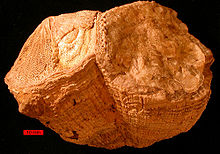Rudists
| Rudists Temporal range:
| |
|---|---|

| |
| Rudist bivalves from the Cretaceous of the Oman Mountains, United Arab Emirates; scale bar is 10 mm | |
| Scientific classification | |
| Domain: | Eukaryota |
| Kingdom: | Animalia |
| Phylum: | Mollusca |
| Class: | Bivalvia |
| Infraclass: | Heteroconchia |
| Subterclass: | Euheterodonta |
| Superorder: | Imparidentia |
| Order: | †Hippuritida |
| Families | |
|
See text | |

Rudists are a group of extinct box-, tube- or ring-shaped
Shell description
The Late Jurassic forms were elongated, with both valves being similarly shaped, often pipe or stake-shaped, while the reef-building forms of the Cretaceous had one valve that became a flat lid, with the other valve becoming an inverted spike-like cone. The size of these conical forms ranged widely from just a few centimeters to well over a meter in length.
Their "classic" morphology consisted of a lower, roughly conical valve that was attached to the seafloor or to neighboring rudists, and a smaller upper valve that served as a kind of lid for the organism. The small upper valve could take a variety of interesting forms, including: a simple flat lid, a low cone, a spiral, and even a star-shaped form.[1]
Fossil range and extinction
The oldest rudists are found in late Jurassic rocks in France.[2]
The rudists became extinct at the end of the Cretaceous, apparently as a result of the Cretaceous–Paleogene extinction event. It had been thought that this group began a decline about 2.5 million years earlier which culminated in complete extinction half a million years before the end of the Cretaceous.[1] The extinction of rudist bivalves was during the Maastrichtian (end of the Cretaceous).[3]
Taxonomy
The rudists are, according to different systematic schemes, placed in the orders Hippuritida (Hippuritoida) or Rudistes (sometimes Rudista).
Order: †Hippuritida
- Suborder: †Hippuritidina
- Superfamily: †Caprinoidea
- Family: †Antillocaprinidae
- Family: †Caprinidae
- Family: †Caprinuloideidae
- Family: †Ichthyosarcolitidae
- Superfamily: †Radiolitoidea
- Family: †Caprotinidae
- Family: †Diceratidae
- Family: †Hippuritidae
- Family: †Plagioptychidae
- Family: †Polyconitidae
- Family: †Radiolitidae
- Superfamily: †Caprinoidea
- Suborder: †Requieniidina
- Superfamily: †Requienioidea
- Family: †Requieniidae
- Family: †Epidiceratidae
- Superfamily: †Requienioidea
Bieler, Carter & Coan in 2010 also named the non-Hippuritid families
Ecology
The classification of rudists as true reef-builders is controversial because they would catch and trap much sediment between their lower conical valves; thus, rudists were not completely composed of biogenic carbonates as a coral would be. However, rudists were one of the most important constituents of
References
- ^ .
- .
- ^ Steuber, T (1999). "Cretaceous rudists of Boeotia, Central Greece". Special Papers in Palaeontology. 61: 1–229.
- S2CID 86546840.
- ^ "Info on Rudists". Paleos.com. The Aptian Age. Archived from the original on 20 December 2010. Retrieved 2 July 2006.
- Simon F. Mitchell (2005). "The oldest barnacle from the Caribbean is a rudist bivalve (Maastrichtian, Jamaica)". Cretaceous Research. 26 (6): 895–897. .
- "An Introduction to the Paleontology of Rudist Bivalves". Retrieved 2 July 2006.
